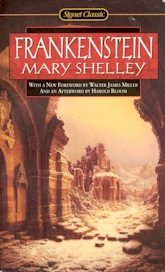
Or, The Modern Prometheus
(1818, revised 1831)
1967 Bantam paperback
cover art by James E. Bama
206 pages (left)
1988 Tor paperback
cover art uncredited
233 pages (right)

Denver Science Fiction & Fantasy Book Club |
 |
Frankenstein Or, The Modern Prometheus (1818, revised 1831) 1967 Bantam paperback cover art by James E. Bama 206 pages (left) 1988 Tor paperback cover art uncredited 233 pages (right) |
 |
 |
More book covers: Frankenstein 2000 Signet Classic paperback Foreword by Walter James Miller Afterword by Harold Bloom 198 pages (left) 1953 Lion Books edition (first paperback edition) cover art uncredited 222 pages (right) |
 |
| Dan | - | Amy | 8 |
 |
10 Wow! Don't miss it 8-9 Highly recommended 7 Recommended 5-6 Mild recommendation 3-4 Take your chances 1-2 Below average; skip it 0 Get out the flamethrower! U Unfinishable or unreadable - Skipped or no rating given |
| Cheri | 7 | Barb | - | ||
| Aaron | 9 | Cynthia | - | ||
| Jackie | 8.5 | Ron | 8 | ||
| Christine | - | Mitch | - |
|
Aaron's Commentary
Mary Shelley - Frankenstein
Frankenstein was a huge influence on both the horror and science fiction genres. As a horror novel, the image of the monster is powerful even today, and must have been shocking to a Nineteenth Century reader. Shelley very effectively builds a sense of dread over Frankenstein's impending doom. More importantly (at least for purposes of our science fiction book group), Frankenstein is arguably the first modern science fiction novel. Shelley is careful to try to justify the tale scientifically, and this plausibility adds impact to the story. Shelley addresses many of the issues that still remain central to science fiction. One is the examination of the alien. The monster is frightening and non-human (as indicated by the fact that he never receives a name), yet he is not evil. He commits terrible acts, but only from rage at being left alone and miserable, the same rage that grips Frankenstein by the end of the novel. A second is the potential effects of new technologies. Frankenstein raises moral issues about the use of technology, such as the morality of building a mate for the monster, and shows the danger of cold rationality, symbolized for example by the frozen wastes where the story culminates. Yet anyone who thinks this novel is just a warning that "there are things that man was not meant to know" is not reading carefully. Frankenstein's passionate speech toward the end suggests that the novel is not meant to condemn scientific progress. The subtitle, The Modern Prometheus, indicates directly to the contrary. It was a good thing for Prometheus to give mankind fire, even if, like Frankenstein, he was tortured for it. Aside from its historical importance, Frankenstein holds up to this day as engaging reading, even if it moves a bit ponderously by modern standards (largely because of some overly detailed stories-within-stories). Both Frankenstein and the monster are sympathetic figures and the scenes where they confront each other are especially effective. In the end, neither has any avenue of escape from his tragic fate. What do you think? Your comments are welcome. Please send them to vanaaron@excite.com |